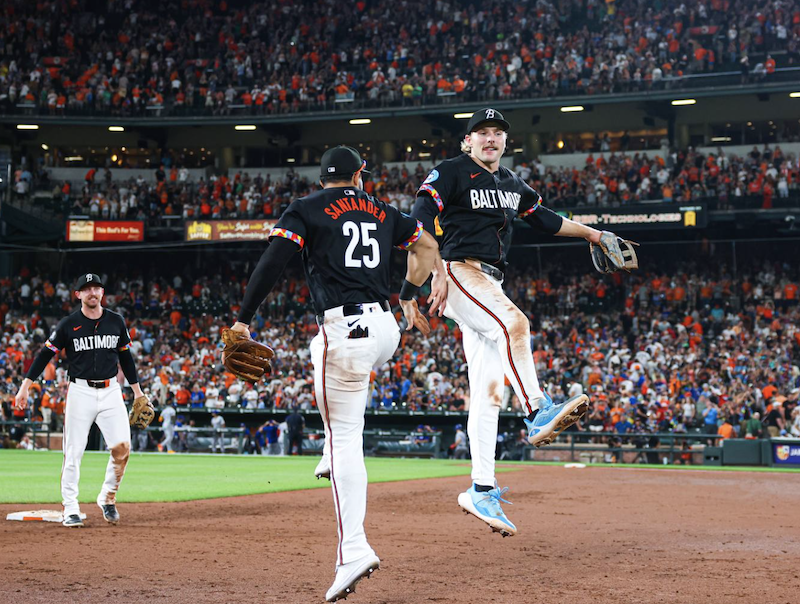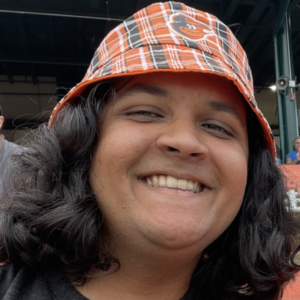Off the bat, it wasn’t immediately clear if Heston Kjerstad’s deep fly ball was going to make it over the centerfield fence. It hung in the Saturday night air for 6.6 seconds, an all-too-perfect representation of the hopes and dreams of the long-suffering Orioles faithful.
Over six seconds in the air is an eternity for a baseball, just as 40 years without a World Series has been an eternity in Baltimore. (For context, Ravens punter Jordan Stout averaged a 4.25-second hangtime last season, and the Ravens won a Super Bowl just 11 years ago.)
The metaphor continued when the ball cleared the outfield wall just over the outstretched glove of Rangers CF Derek Hill. Launched at 39º with an exit velocity of 105 mph, Kjerstad’s blast had an xBA of .500 and a 46.4% chance of reaching the bleachers, per Statcast. A few degrees higher or a few miles-per-hour slower, and those numbers drop precipitously. Like the Orioles all month, Kjerstad had a thin margin for error with a cutter bearing in on his fists.
He responded like the Orioles did to their daunting schedule and bevy of pitcher injuries throughout June: with a home run. The rookie outfielder flashed his quick hands and blazing bat speed to muscle the ball 395 feet to drive in four of Baltimore’s six runs on one swing.
Kjerstad’s grand slam was the Orioles’ 60th home run of June, joining the 2019 New York Yankees and 2023 Atlanta Braves as the only teams to reach that mark in a single month in MLB history. That power surge has been the team’s response to the decimation of their pitching staff, an indignant insistence on their claim to being the best team in baseball.
The Orioles’ output in June represents the franchise’s literal staying power in the MLB, both in the 2024 season and for the rest of the decade. The Orioles’ established stars – Gunnar Henderson (8 home runs), Adley Rutschman (5), Ryan Mountcastle (5) – accounted for 30% of the team’s June homers, but the contributions came from every single player in the lineup.
All 15 players Brandon Hyde sent to bat in June homered, led by a resurgent Anthony Santander who clubbed 13 taters, more than doubling his total from the previous two months. Cedric Mullins hit his first three since April, and Austin Hays hit his first three all year! Ryan O’Hearn recorded at least three home runs for the third straight month, and James McCann hit two in only 18 at bats. Ramón Urias and Jorge Mateo each added a pair, too, completing a solid month for the Orioles’ varied group of veterans.
Even more exciting is the performance of the Orioles’ youngest batters against a tough slate of pitchers with just one day of rest in the entire month. Colton Cowser rediscovered his April power with five homers, and Jordan Westburg continued a quietly-excellent year with five of his own. Kjerstad and Connor Norby both hit their first career home runs in June, and even Kyle Stowers was able to join the fun before being sent back down to AAA Norfolk.
But after battling through several of the league’s best lineups, the wheels finally came off the pitching staff, which allowed a league-high 163 runs by the end of the month. Sure, that makes their 17 wins – also a league-high – even more impressive, but that’s hardly sustainable for a team with pennant hopes. As much as June made it seem possible, the Orioles can’t simply power their way to the World Series. They surrendered at least eight runs in four separate games from June 21 to June 30, two in starts by Cole Irvin, plus one each from Albert Suarez and Grayson Rodriguez.
The Orioles won’t be worried about Rodriguez, who has better advanced metrics than his 3.72 ERA suggests and has proven his mettle through some tough starts already in his young career. Case in point: after his worst start since April on June 21, he bounced back right away with a quality start in his next appearance.
But the rest of the rotation outside of the uber-consistent Corbin Burnes is cause for concern. Cade Povich and Suarez are separated by a decade, but they inspire the same feeling when pitching: waiting for the other shoe to drop. Povich improved from a six-run debut to only allow six runs across his next four starts, but major league hitting adjustments can be sudden and violent. Suarez has been a revelation all year, even bouncing back from a season-high five runs on June 23 for a quality start in his next outing, but his underlying statistics are middling at best. Will his 2.43 ERA still be a top-10 figure once he’s pitched enough innings to qualify for the league leaderboard?
Even if Suarez and Povich can hold down rotation spots, the Orioles are still missing a reliable fifth starter for the rest of the season. Irvin strung together a few solid starts to kick off June, but his dismal advanced metrics finally caught up to his results with at least five runs in less than five innings of work in his last three starts. Dean Kremer had a 3.72 ERA before his injury against the Cardinals on May 20, but the Orioles should know better by now than to rest their hopes on a pitcher returning from injury.
So beckons July, a month to separate contenders from pretenders and buyers from sellers. Make no mistake: the Orioles belong firmly in the contender/buyer category, but other teams have to figure out their statuses to determine who will be on the trade block.
Meanwhile, Mike Elias has to decide which of his prized young bats he can bear to part with. Jackson Holliday is off-limits, and the recent performances of Coby Mayo and Samuel Basallo could elevate them to that list as well. Such a tight grip on the Orioles’ top prospects would likely preclude a deal for an ace like the Rangers’ Max Scherzer or Garrett Crochet from the White Sox.
Elias could instead dangle second-tier prospects like Connor Norby and Kyle Stowers and pursue controllable pitchers who currently occupy the top of a bad team’s rotation like Crochet’s teammate Erick Fedde or the Angels’ Tyler Anderson. With the presence of Burnes and the potential of Rodriguez, either would likely be moved into a no. 3 starter role in Baltimore. That takes some of the immediate pressure off, and having them under contract through at least 2025 means the adjustment investment now can pay dividends beyond just this season.
There are two clear takeaways from what was ultimately a satisfying June for the Orioles. First, this lineup can absolutely rake, top to bottom. There is no deficit they cannot overcome, there is no pitch they cannot hit out of the ballpark.
But secondly, and perhaps more importantly for the team’s World Series prospects, Baltimore needs to add pitching at the deadline. The Orioles’ margins on the mound are as thin as Kjerstad’s were at the plate on that thrilling Saturday night, and like his powerful young outfielder, Mike Elias will have to make all the right moves to get the Orioles’ season over the fence.












One Response
Our pitching is devastated. I would not be surprised if we fell off as the season goes on.
But it’s okay. We’re super young, and we have a bright future. And one of the lowest payrolls in the game. It’s just a shame what’s happening to pitchers these days. They’re throwing so damn hard!